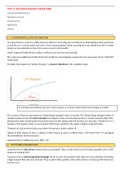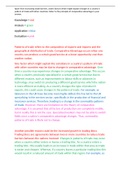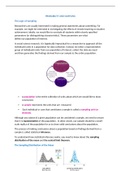UNIT 4: DECISION MAKING UNDER RISK
Conventional utility function
Attitudes toward risk
Prospect theory
Applications
Exercise
1. A CONVENTIONAL UTILITY FUNCTION
It is described as a concave utility function which is increasing (not strictly but by diminishing units) and tends
to stabilise at a certain point and with a decreasing marginal utility meaning that any additional unit it would
bring you less satisfaction than if you were at your initial wealth.
Under Expected Utility Model, utility is defined over final and total wealth.
The value of an additional €100 when I have €100 in is much higher compared to the case when I have 1,000,000
in the bank.
Formally this makes the “utility of money” a concave function of the available funds.
It is immaterial whether you have a loss or gain, so it doesn’t take matter that change in wealth
The concave function represents the diminishing marginal value of wealth. The diminishing marginal value of
wealth explains in fact the risk aversion that happens when an individual prefers a certain amount rather than
playing the lottery meaning that the person does not like taking risks but having sure amounts. Therefore, it is a
tendency that people prefer a sure amount rather than a gamble with equal or higher expected value.
*Example of risk aversion behaviour where the person chooses option B:
Option A: 50% chance to have 1 million or 50% chance to have 7 million: U(A) = 0.5*10+0.5*84 = 47 (multiply
the probabilities by the outcome)
Option B: Have 4 million for sure: U(B) = 60
2. ATTITUDES TOWARDS RISK
Someone who is risk averse would reject a fair gamble: They would rather have €10 than a gamble with a 50%
chance of winning €20.
Someone who is risk loving (risk seeking) would accept a fair gamble when they have a probability of winning
a high amount than the sure amount: They would rather gamble with a 50% chance of winning €20 than have
€10 for sure.
, • If the function is concave, we would say that is risk aversion.
• If the function is linear, we would say that is risk neutral
• If the function is convex, we would say that us risk loving
2.1 FOURFOLD PATTERN OF RISK ATTITUDES
If we look at this combination between the outcomes, if they are high or if they are low, with the probabilities, if
we have low probability or high probability, this matrix gives ,us four behaviours:
1. HIGH OUTCOME PROBABILITY + GAINS: The person chooses the high probability to gain a certain
amount rather than playing the gamble
2. HIGH OUTCOME PROBABILITY + LOSEES: The person would play the gamble even if they can lose money
for sure
3. LOW OUTCOME PROBABILITY + GAINS: People are attracted with this hope of large gain and therefore
they play
4. HIGH OUTCOME PROBABILITY + LOSSES
3. PROSPECT THEORY(PT)
Prospect theory helps in modelling all those multiple dimensions of risk preferences (low or high
probabilities/gain or losses). So, the prospect theory is a complex theory that models risk preferences as a multi-
faceted concept.
The main departure of prospect theory from expected utility theory is the change in wealth Under expected utility
theory the utility defined over lifetime (final) wealth defines risk preferences.
Conventional utility function
Attitudes toward risk
Prospect theory
Applications
Exercise
1. A CONVENTIONAL UTILITY FUNCTION
It is described as a concave utility function which is increasing (not strictly but by diminishing units) and tends
to stabilise at a certain point and with a decreasing marginal utility meaning that any additional unit it would
bring you less satisfaction than if you were at your initial wealth.
Under Expected Utility Model, utility is defined over final and total wealth.
The value of an additional €100 when I have €100 in is much higher compared to the case when I have 1,000,000
in the bank.
Formally this makes the “utility of money” a concave function of the available funds.
It is immaterial whether you have a loss or gain, so it doesn’t take matter that change in wealth
The concave function represents the diminishing marginal value of wealth. The diminishing marginal value of
wealth explains in fact the risk aversion that happens when an individual prefers a certain amount rather than
playing the lottery meaning that the person does not like taking risks but having sure amounts. Therefore, it is a
tendency that people prefer a sure amount rather than a gamble with equal or higher expected value.
*Example of risk aversion behaviour where the person chooses option B:
Option A: 50% chance to have 1 million or 50% chance to have 7 million: U(A) = 0.5*10+0.5*84 = 47 (multiply
the probabilities by the outcome)
Option B: Have 4 million for sure: U(B) = 60
2. ATTITUDES TOWARDS RISK
Someone who is risk averse would reject a fair gamble: They would rather have €10 than a gamble with a 50%
chance of winning €20.
Someone who is risk loving (risk seeking) would accept a fair gamble when they have a probability of winning
a high amount than the sure amount: They would rather gamble with a 50% chance of winning €20 than have
€10 for sure.
, • If the function is concave, we would say that is risk aversion.
• If the function is linear, we would say that is risk neutral
• If the function is convex, we would say that us risk loving
2.1 FOURFOLD PATTERN OF RISK ATTITUDES
If we look at this combination between the outcomes, if they are high or if they are low, with the probabilities, if
we have low probability or high probability, this matrix gives ,us four behaviours:
1. HIGH OUTCOME PROBABILITY + GAINS: The person chooses the high probability to gain a certain
amount rather than playing the gamble
2. HIGH OUTCOME PROBABILITY + LOSEES: The person would play the gamble even if they can lose money
for sure
3. LOW OUTCOME PROBABILITY + GAINS: People are attracted with this hope of large gain and therefore
they play
4. HIGH OUTCOME PROBABILITY + LOSSES
3. PROSPECT THEORY(PT)
Prospect theory helps in modelling all those multiple dimensions of risk preferences (low or high
probabilities/gain or losses). So, the prospect theory is a complex theory that models risk preferences as a multi-
faceted concept.
The main departure of prospect theory from expected utility theory is the change in wealth Under expected utility
theory the utility defined over lifetime (final) wealth defines risk preferences.











